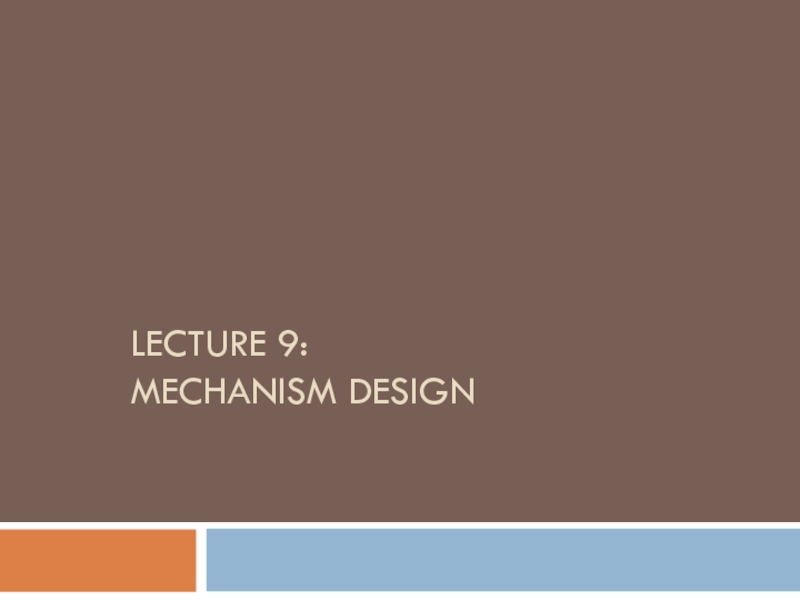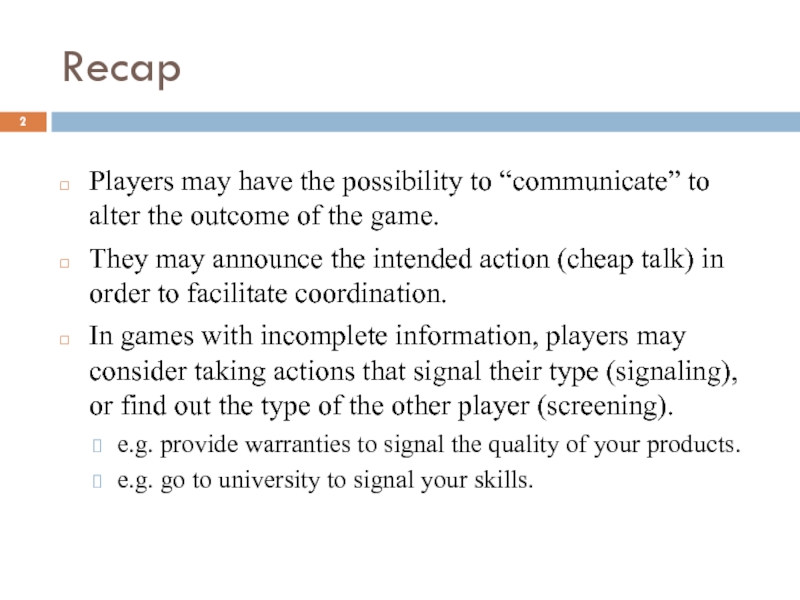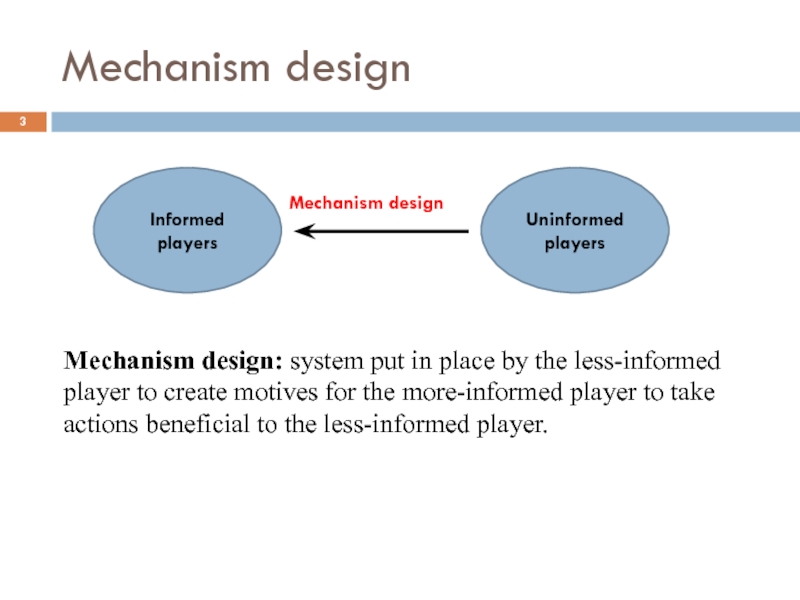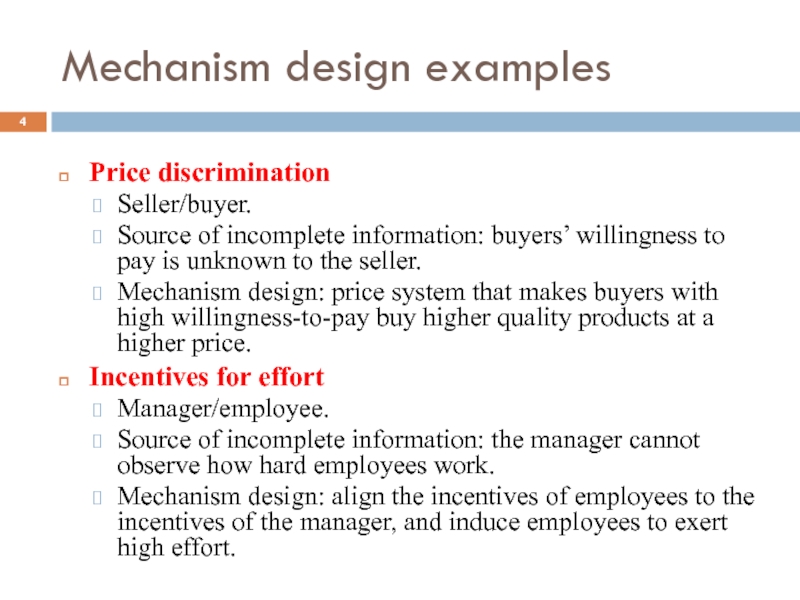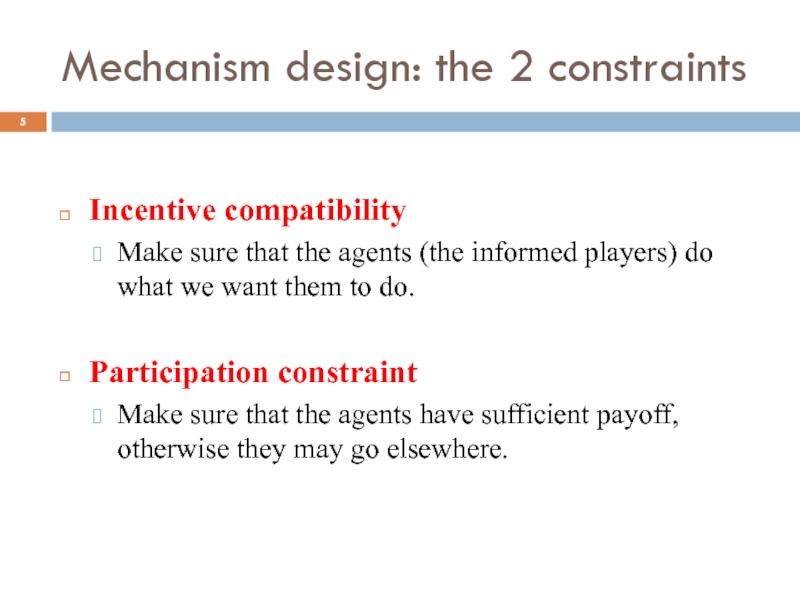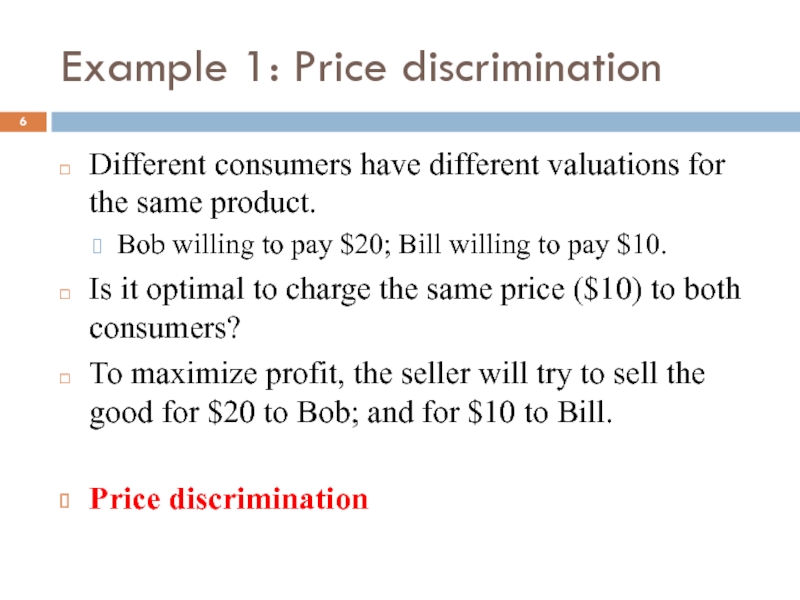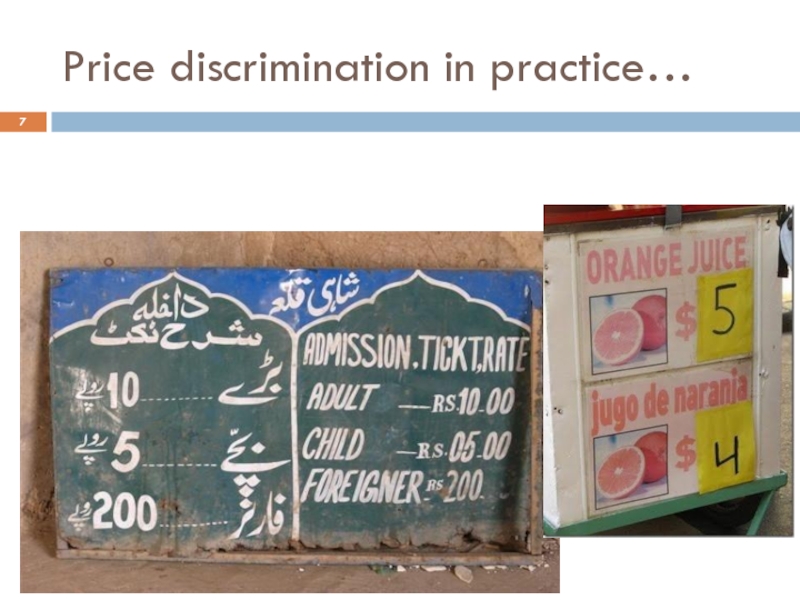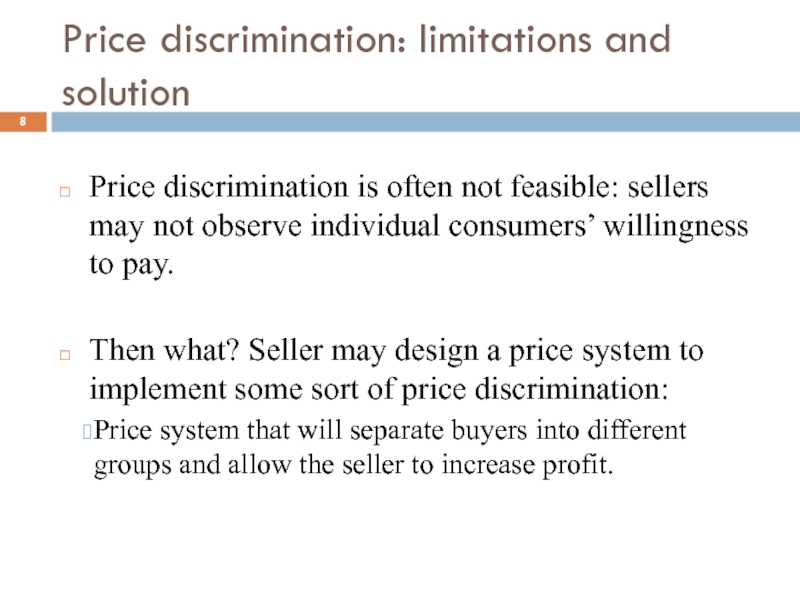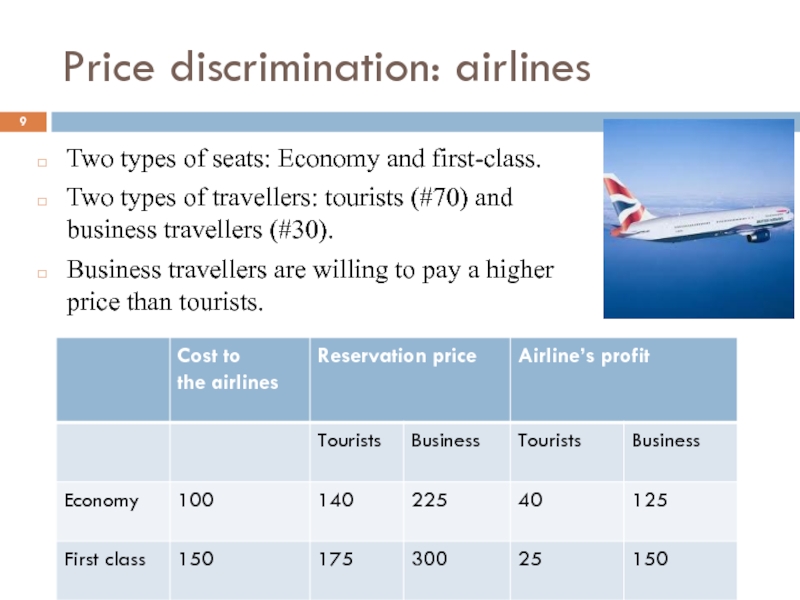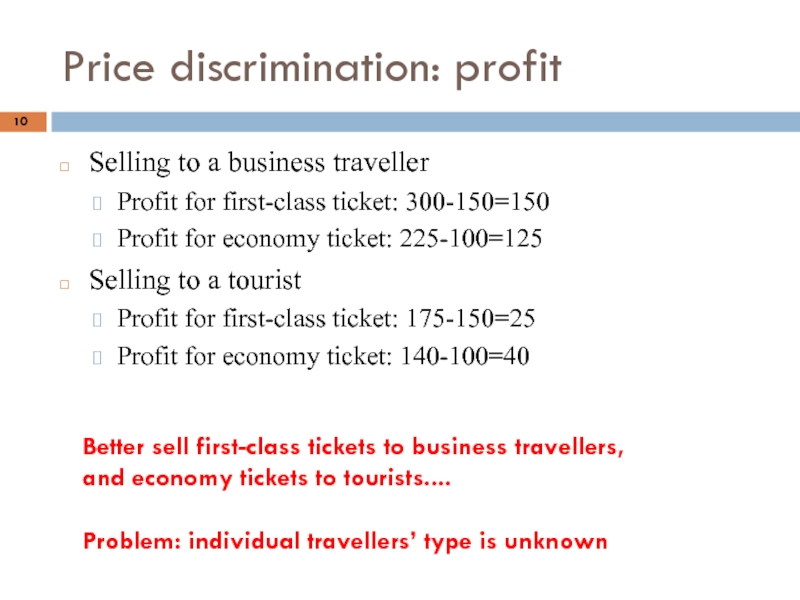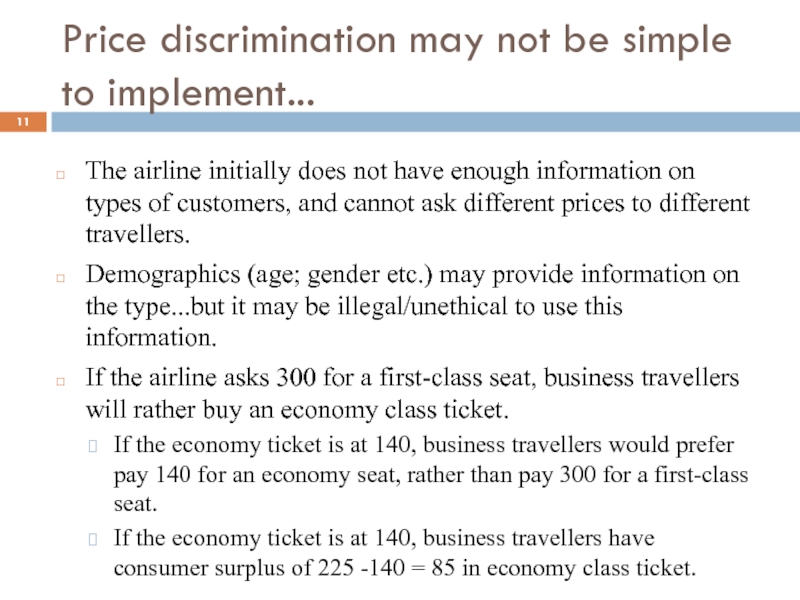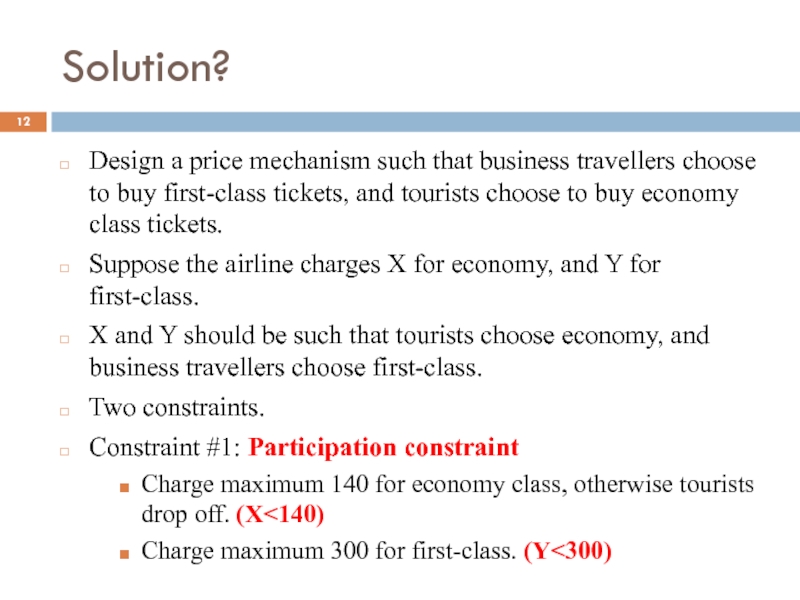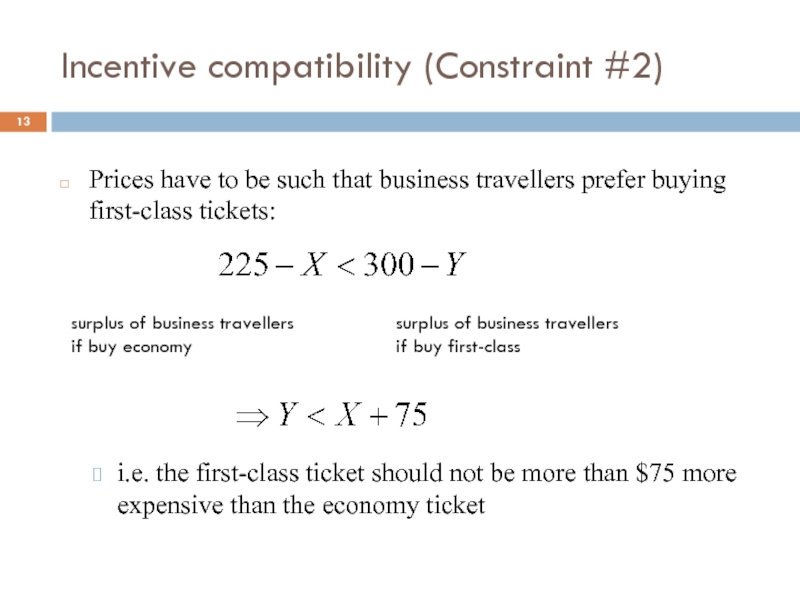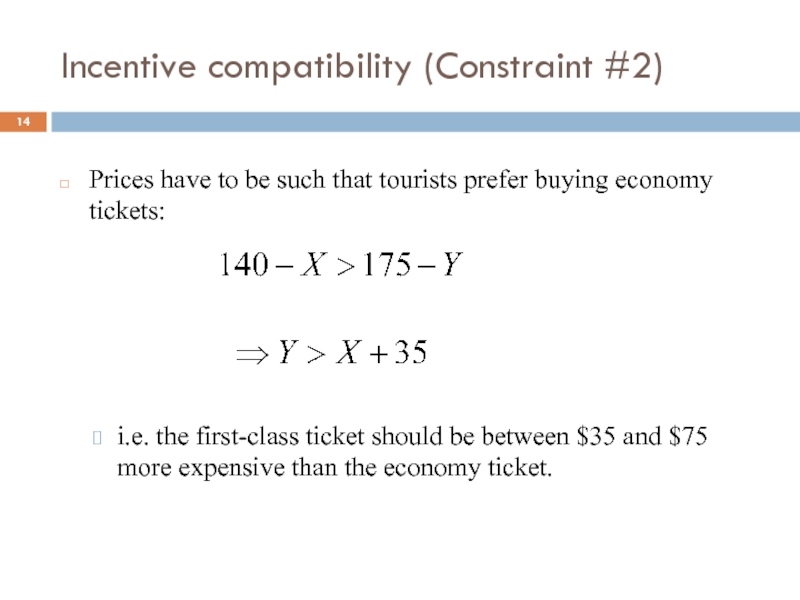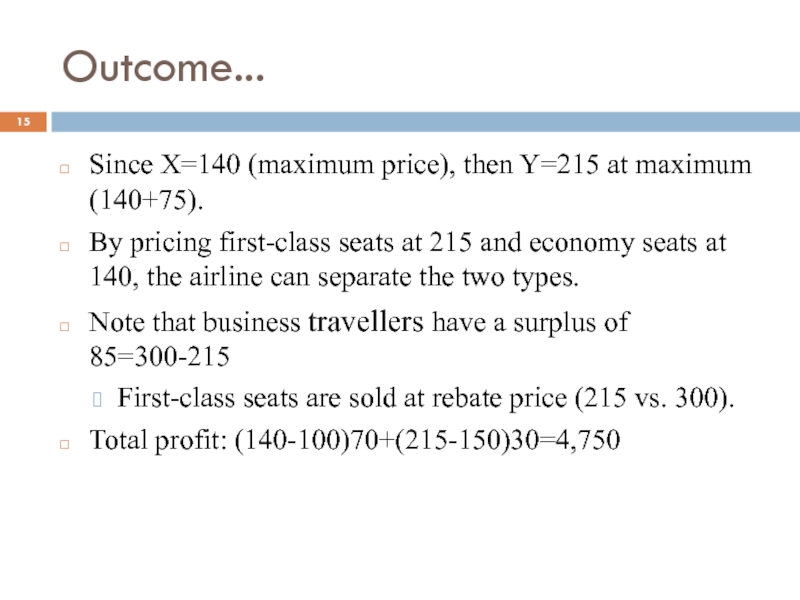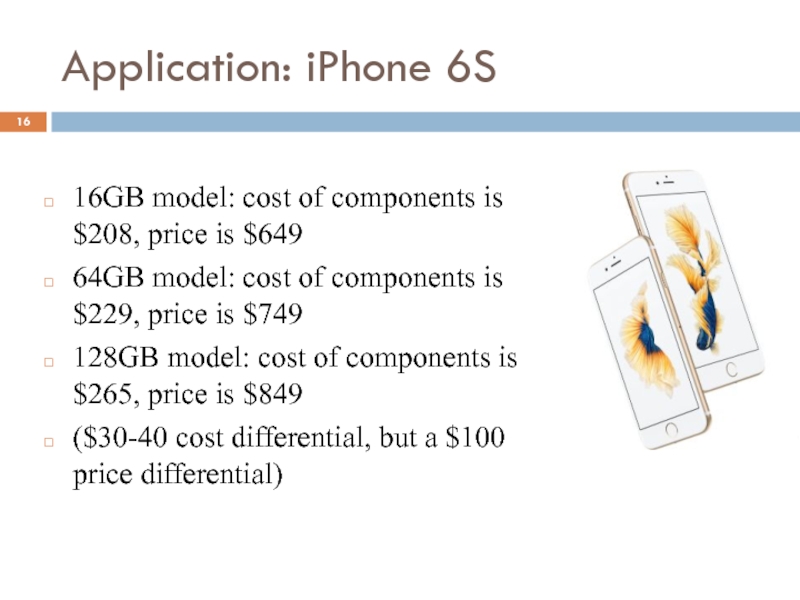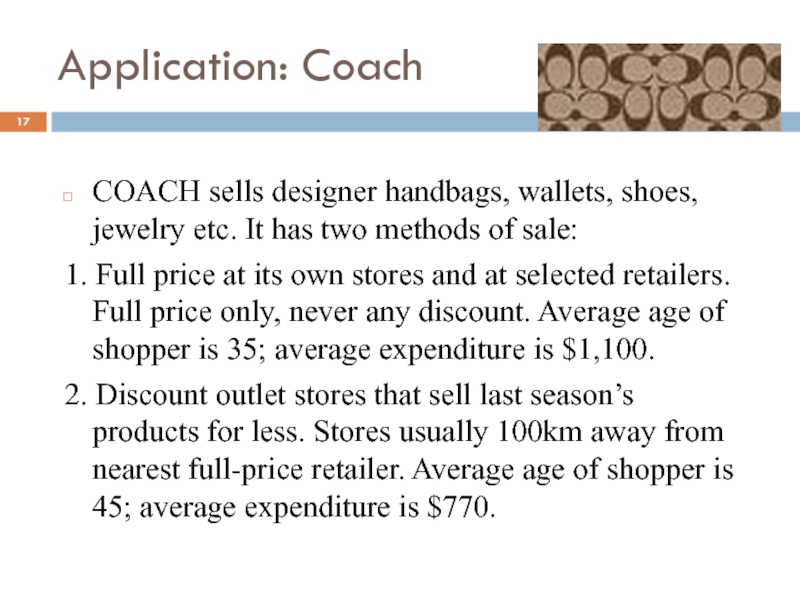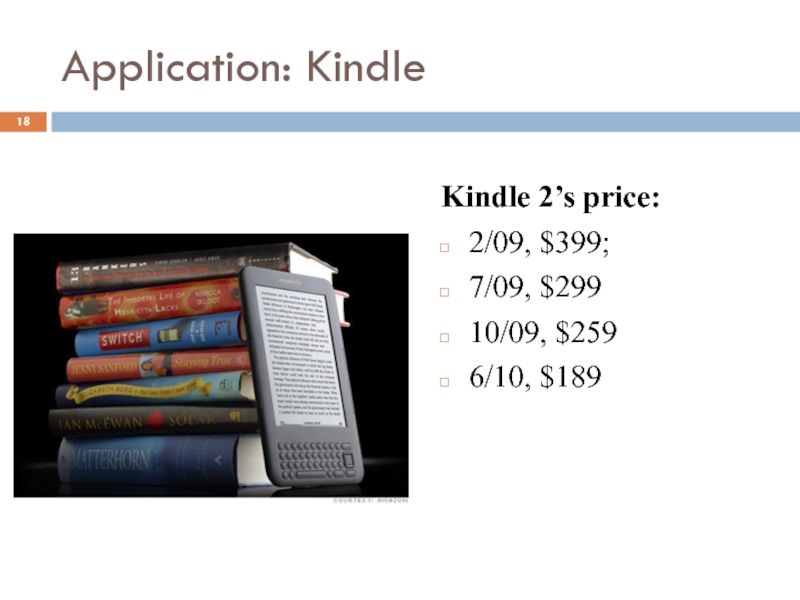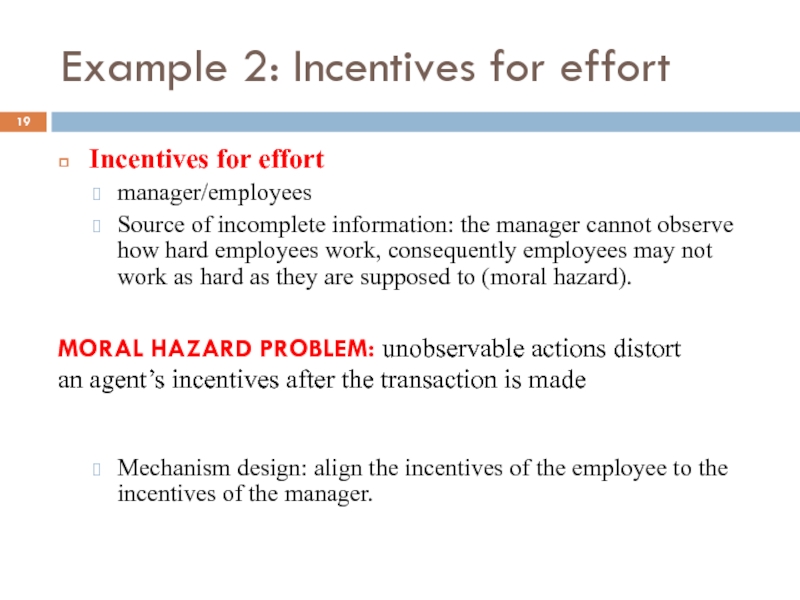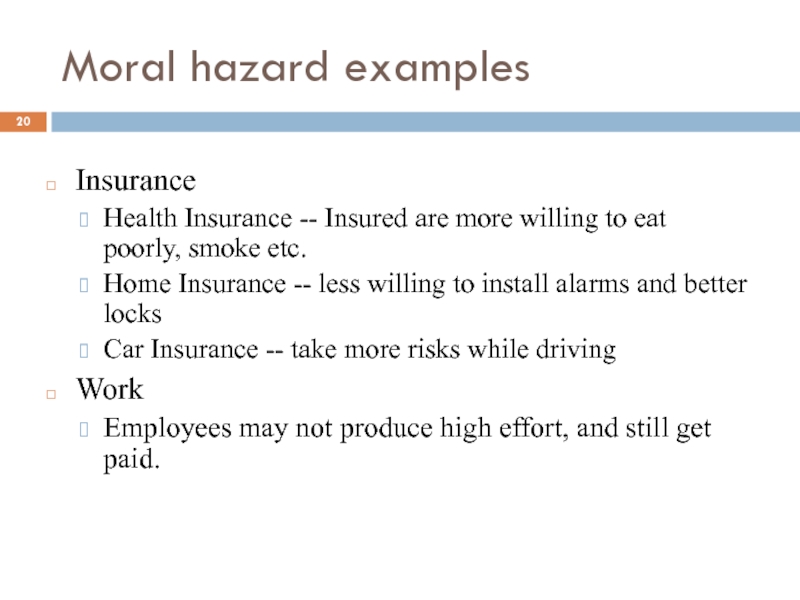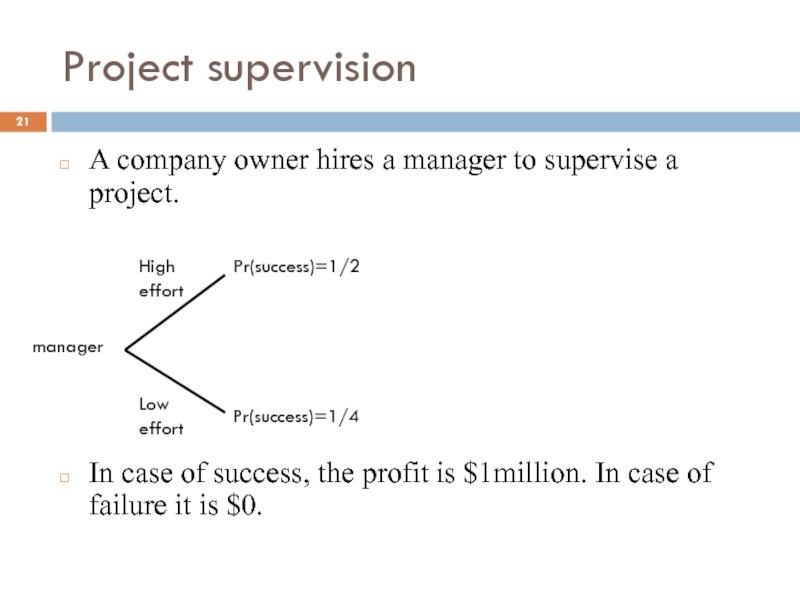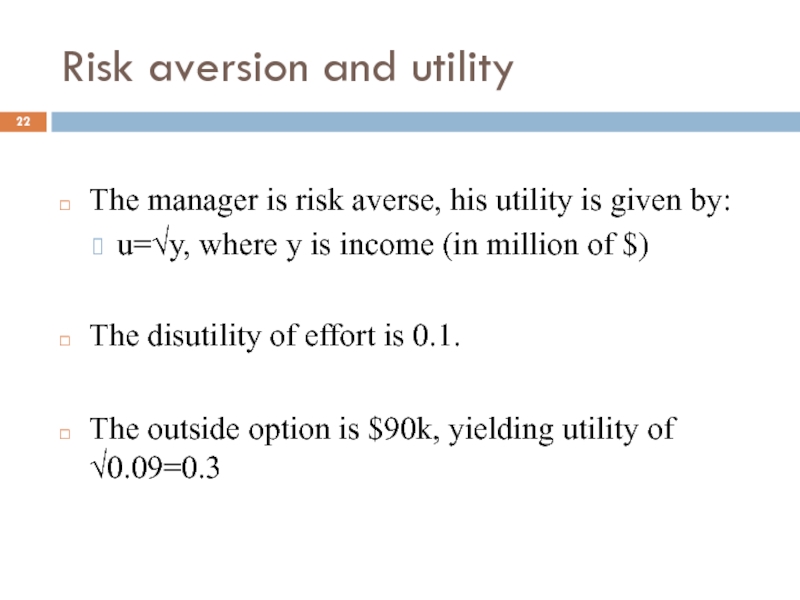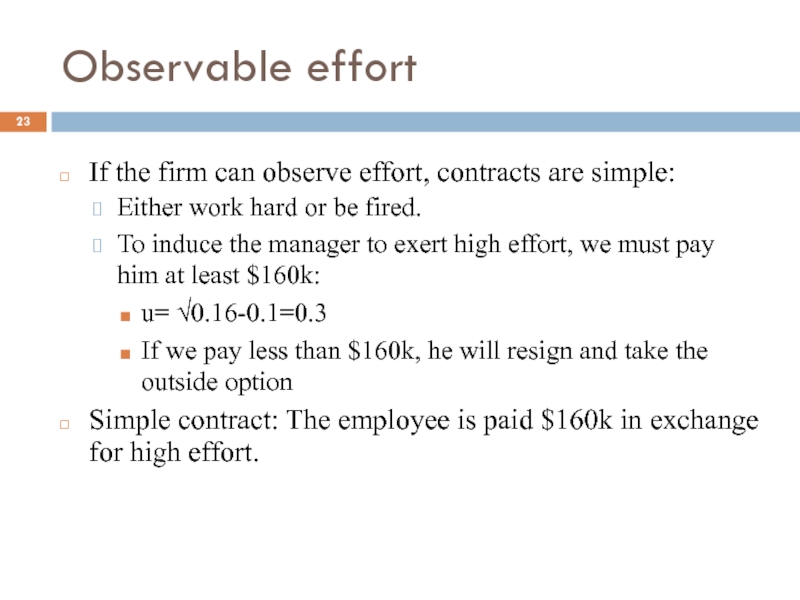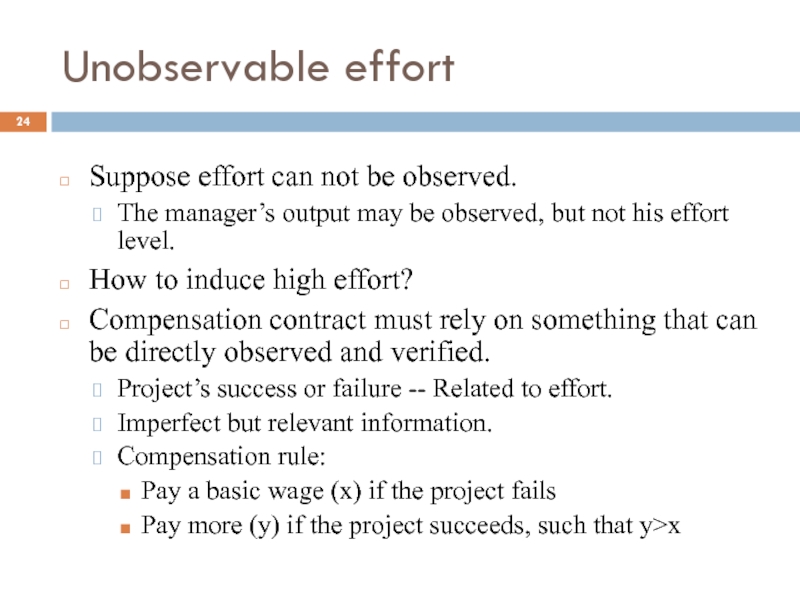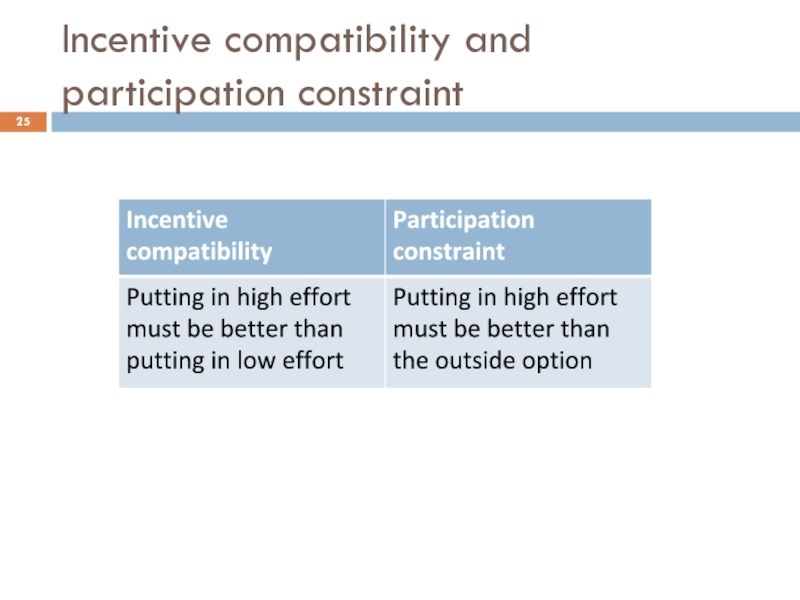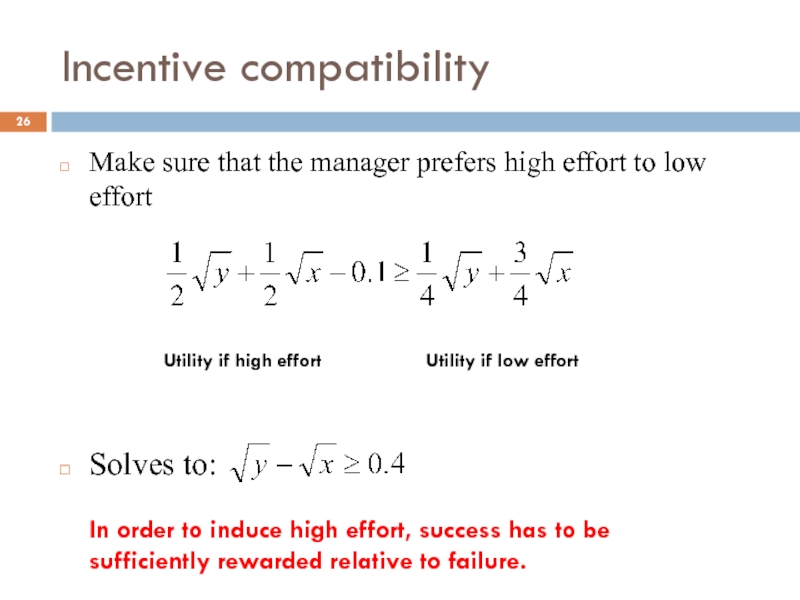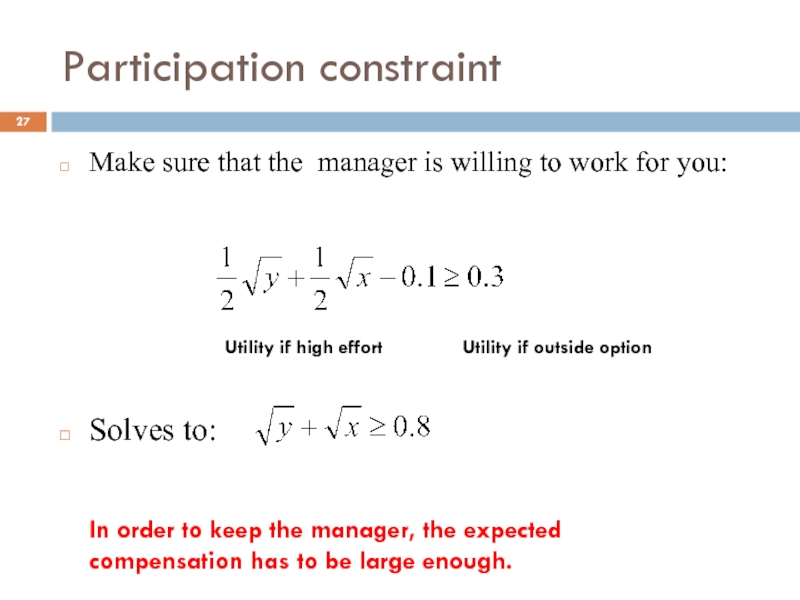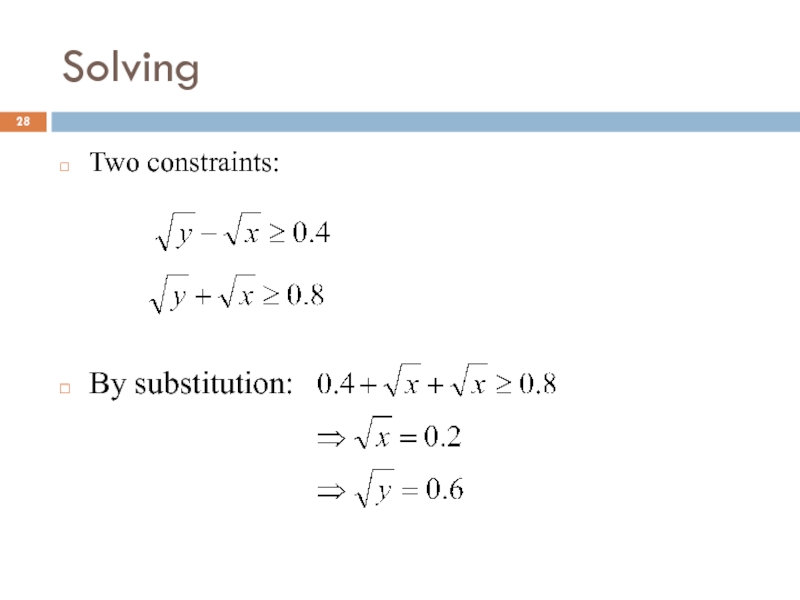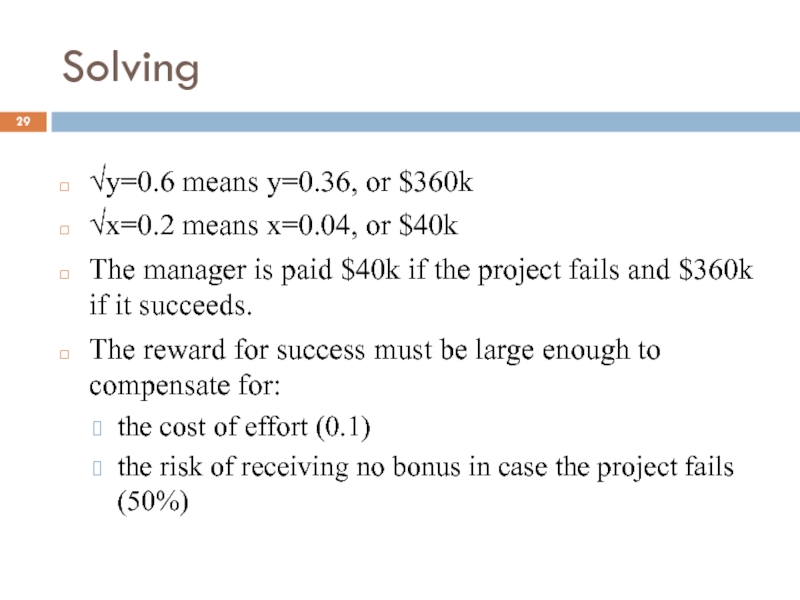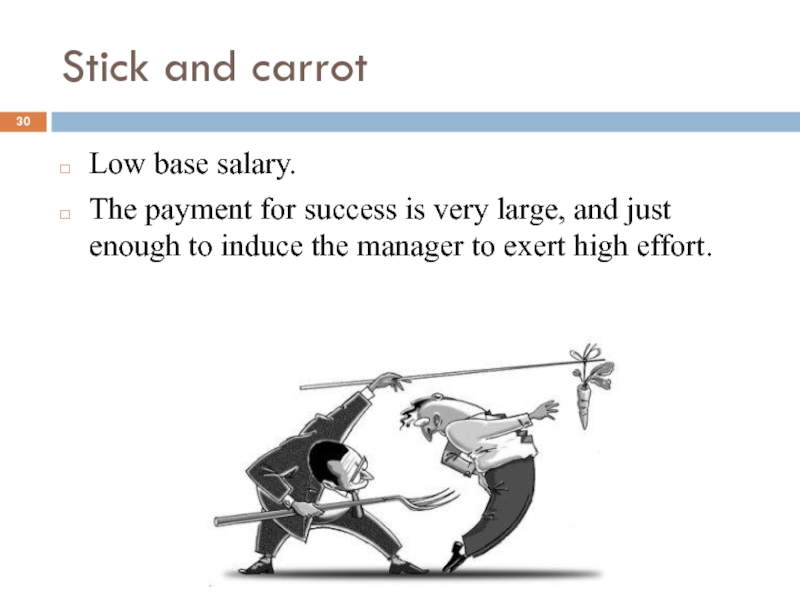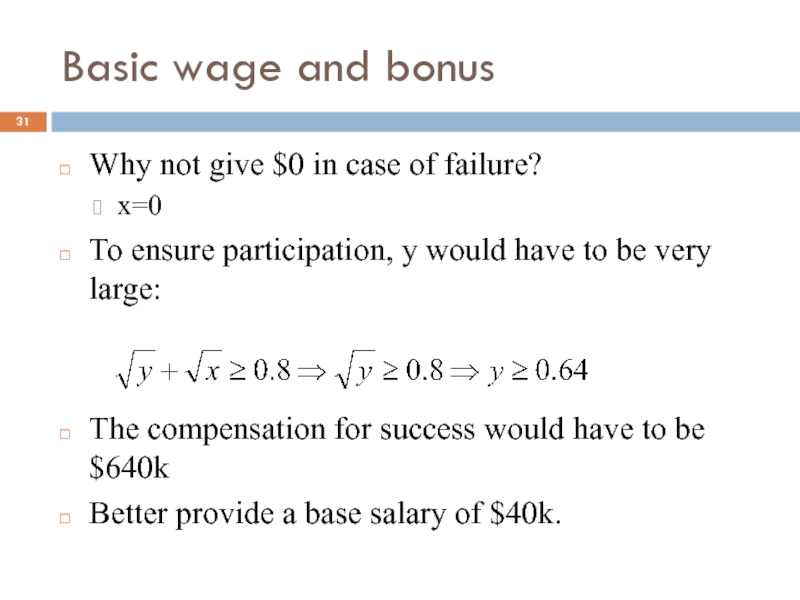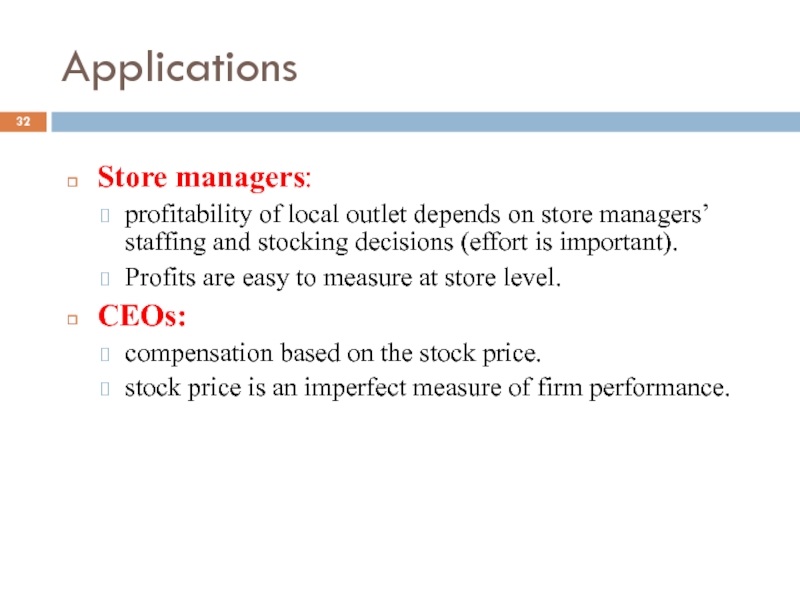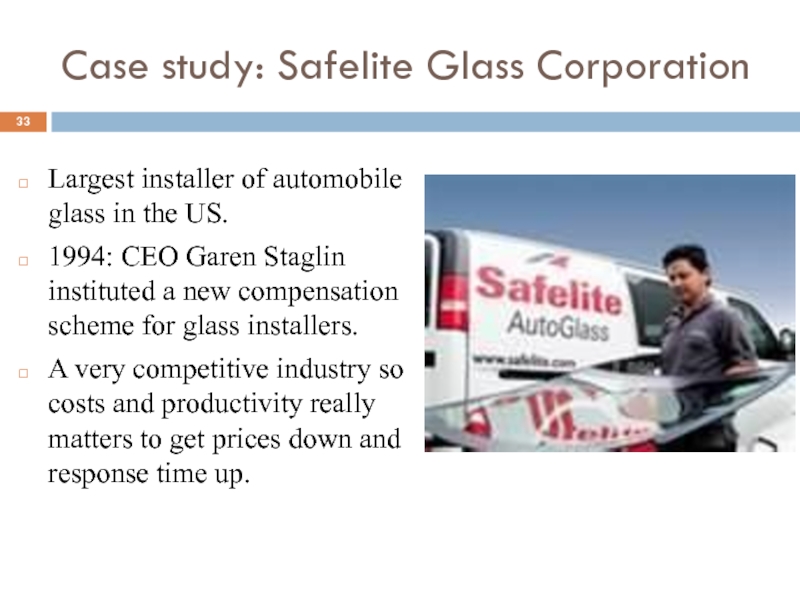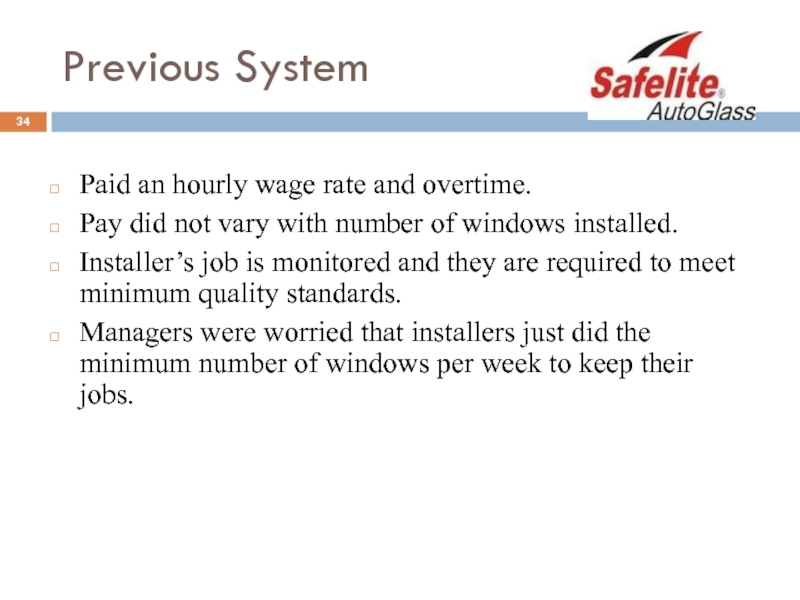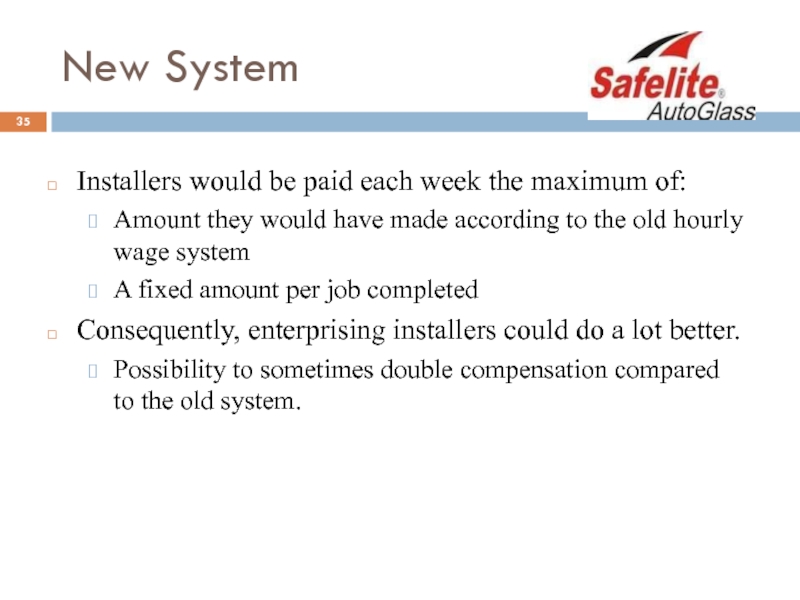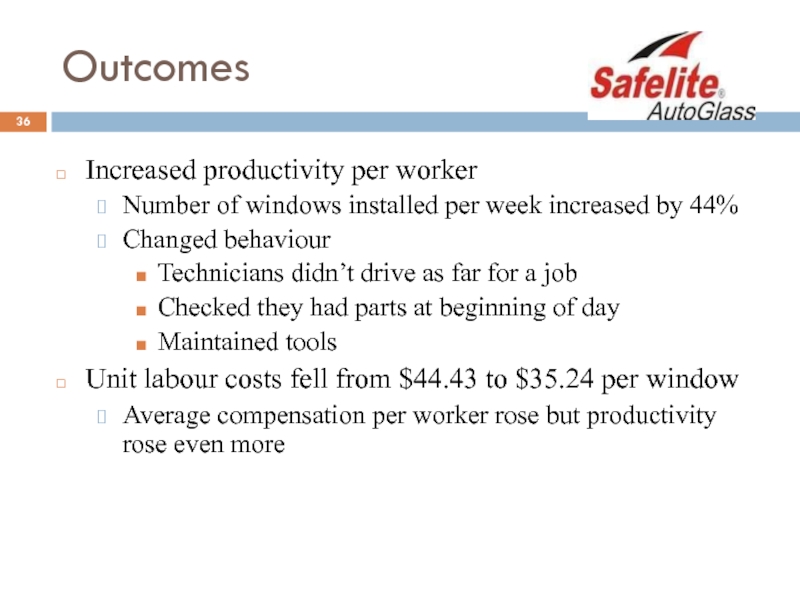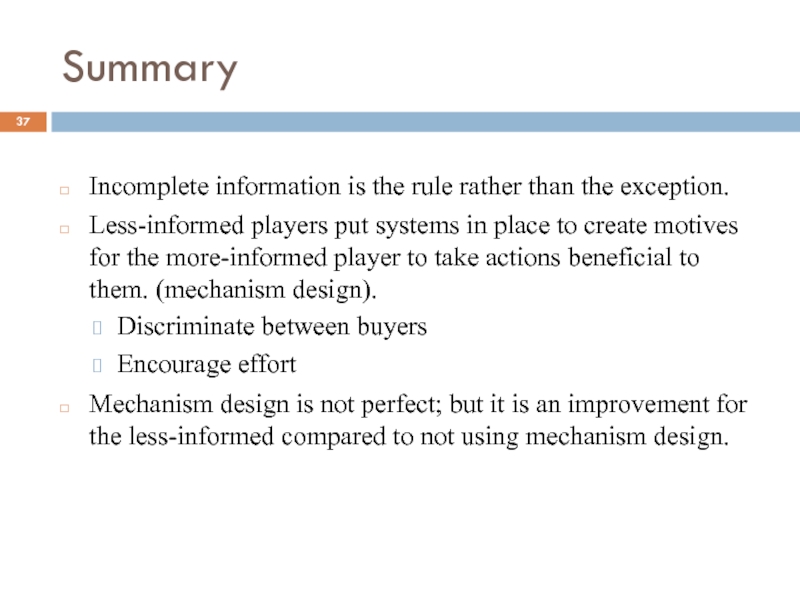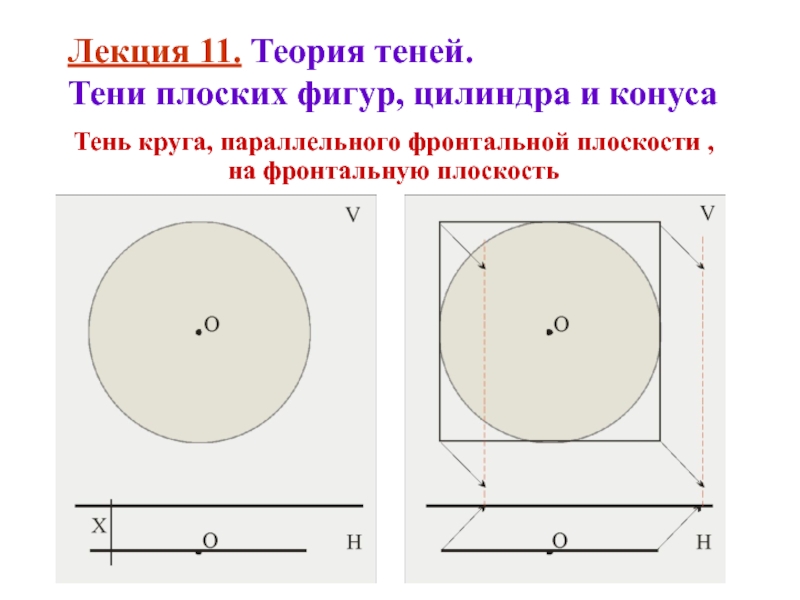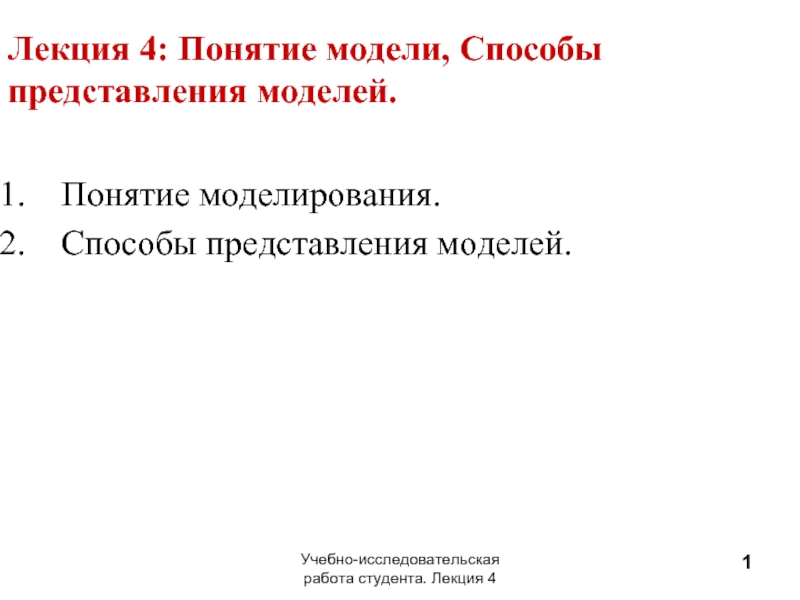- Главная
- Разное
- Дизайн
- Бизнес и предпринимательство
- Аналитика
- Образование
- Развлечения
- Красота и здоровье
- Финансы
- Государство
- Путешествия
- Спорт
- Недвижимость
- Армия
- Графика
- Культурология
- Еда и кулинария
- Лингвистика
- Английский язык
- Астрономия
- Алгебра
- Биология
- География
- Детские презентации
- Информатика
- История
- Литература
- Маркетинг
- Математика
- Медицина
- Менеджмент
- Музыка
- МХК
- Немецкий язык
- ОБЖ
- Обществознание
- Окружающий мир
- Педагогика
- Русский язык
- Технология
- Физика
- Философия
- Химия
- Шаблоны, картинки для презентаций
- Экология
- Экономика
- Юриспруденция
Mechanism design. (Lecture 9) презентация
Содержание
- 1. Mechanism design. (Lecture 9)
- 2. Recap Players may have the possibility to
- 3. Mechanism design
- 4. Mechanism design examples Price discrimination Seller/buyer. Source
- 5. Mechanism design: the 2 constraints Incentive
- 6. Example 1: Price discrimination Different consumers have
- 7. Price discrimination in practice…
- 8. Price discrimination: limitations and solution Price discrimination
- 9. Price discrimination: airlines Two types of seats:
- 10. Price discrimination: profit Selling to a business
- 11. Price discrimination may not be simple to
- 12. Solution? Design a price mechanism such
- 13. Incentive compatibility (Constraint #2) Prices have to
- 14. Incentive compatibility (Constraint #2) Prices have to
- 15. Outcome... Since X=140 (maximum price), then Y=215
- 16. Application: iPhone 6S 16GB model: cost of
- 17. Application: Coach COACH sells designer handbags, wallets,
- 18. Application: Kindle Kindle 2’s price: 2/09,
- 19. Example 2: Incentives for effort Incentives for
- 20. Moral hazard examples Insurance Health Insurance --
- 21. Project supervision A company owner hires a
- 22. Risk aversion and utility The manager
- 23. Observable effort If the firm can observe
- 24. Unobservable effort Suppose effort can not be
- 25. Incentive compatibility and participation constraint
- 26. Incentive compatibility Make sure that the manager
- 27. Participation constraint Make sure that the manager
- 28. Solving Two constraints: By substitution:
- 29. Solving √y=0.6 means y=0.36, or $360k √x=0.2
- 30. Stick and carrot Low base salary.
- 31. Basic wage and bonus Why not give
- 32. Applications Store managers: profitability of local
- 33. Case study: Safelite Glass Corporation Largest installer
- 34. Previous System Paid an hourly wage rate
- 35. New System Installers would be paid each
- 36. Outcomes Increased productivity per worker Number of
- 37. Summary Incomplete information is the rule rather
Слайд 2Recap
Players may have the possibility to “communicate” to alter the outcome
They may announce the intended action (cheap talk) in order to facilitate coordination.
In games with incomplete information, players may consider taking actions that signal their type (signaling), or find out the type of the other player (screening).
e.g. provide warranties to signal the quality of your products.
e.g. go to university to signal your skills.
Слайд 3Mechanism design
Informed players
Uninformed players
Mechanism design
Mechanism design: system put in place by
Слайд 4Mechanism design examples
Price discrimination
Seller/buyer.
Source of incomplete information: buyers’ willingness to pay
Mechanism design: price system that makes buyers with high willingness-to-pay buy higher quality products at a higher price.
Incentives for effort
Manager/employee.
Source of incomplete information: the manager cannot observe how hard employees work.
Mechanism design: align the incentives of employees to the incentives of the manager, and induce employees to exert high effort.
Слайд 5Mechanism design: the 2 constraints
Incentive compatibility
Make sure that the agents (the
Participation constraint
Make sure that the agents have sufficient payoff, otherwise they may go elsewhere.
Слайд 6Example 1: Price discrimination
Different consumers have different valuations for the same
Bob willing to pay $20; Bill willing to pay $10.
Is it optimal to charge the same price ($10) to both consumers?
To maximize profit, the seller will try to sell the good for $20 to Bob; and for $10 to Bill.
Price discrimination
Слайд 8Price discrimination: limitations and solution
Price discrimination is often not feasible: sellers
Then what? Seller may design a price system to implement some sort of price discrimination:
Price system that will separate buyers into different groups and allow the seller to increase profit.
Слайд 9Price discrimination: airlines
Two types of seats: Economy and first-class.
Two types
Business travellers are willing to pay a higher price than tourists.
Слайд 10Price discrimination: profit
Selling to a business traveller
Profit for first-class ticket: 300-150=150
Profit
Selling to a tourist
Profit for first-class ticket: 175-150=25
Profit for economy ticket: 140-100=40
Better sell first-class tickets to business travellers,
and economy tickets to tourists....
Problem: individual travellers’ type is unknown
Слайд 11Price discrimination may not be simple to implement...
The airline initially does
Demographics (age; gender etc.) may provide information on the type...but it may be illegal/unethical to use this information.
If the airline asks 300 for a first-class seat, business travellers will rather buy an economy class ticket.
If the economy ticket is at 140, business travellers would prefer pay 140 for an economy seat, rather than pay 300 for a first-class seat.
If the economy ticket is at 140, business travellers have consumer surplus of 225 -140 = 85 in economy class ticket.
Слайд 12Solution?
Design a price mechanism such that business travellers choose to
Suppose the airline charges X for economy, and Y for first-class.
X and Y should be such that tourists choose economy, and business travellers choose first-class.
Two constraints.
Constraint #1: Participation constraint
Charge maximum 140 for economy class, otherwise tourists drop off. (X<140)
Charge maximum 300 for first-class. (Y<300)
Слайд 13Incentive compatibility (Constraint #2)
Prices have to be such that business travellers
i.e. the first-class ticket should not be more than $75 more expensive than the economy ticket
surplus of business travellers
if buy economy
surplus of business travellers
if buy first-class
Слайд 14Incentive compatibility (Constraint #2)
Prices have to be such that tourists prefer
i.e. the first-class ticket should be between $35 and $75 more expensive than the economy ticket.
Слайд 15Outcome...
Since X=140 (maximum price), then Y=215 at maximum (140+75).
By pricing first-class
Note that business travellers have a surplus of 85=300-215
First-class seats are sold at rebate price (215 vs. 300).
Total profit: (140-100)70+(215-150)30=4,750
Слайд 16Application: iPhone 6S
16GB model: cost of components is $208, price is
64GB model: cost of components is $229, price is $749
128GB model: cost of components is $265, price is $849
($30-40 cost differential, but a $100 price differential)
Слайд 17Application: Coach
COACH sells designer handbags, wallets, shoes, jewelry etc. It has
1. Full price at its own stores and at selected retailers. Full price only, never any discount. Average age of shopper is 35; average expenditure is $1,100.
2. Discount outlet stores that sell last season’s products for less. Stores usually 100km away from nearest full-price retailer. Average age of shopper is 45; average expenditure is $770.
Слайд 19Example 2: Incentives for effort
Incentives for effort
manager/employees
Source of incomplete information: the
Mechanism design: align the incentives of the employee to the incentives of the manager.
MORAL HAZARD PROBLEM: unobservable actions distort
an agent’s incentives after the transaction is made
Слайд 20Moral hazard examples
Insurance
Health Insurance -- Insured are more willing to eat
Home Insurance -- less willing to install alarms and better locks
Car Insurance -- take more risks while driving
Work
Employees may not produce high effort, and still get paid.
Слайд 21Project supervision
A company owner hires a manager to supervise a project.
In
High
effort
Low
effort
Pr(success)=1/2
Pr(success)=1/4
manager
Слайд 22Risk aversion and utility
The manager is risk averse, his utility is
u=√y, where y is income (in million of $)
The disutility of effort is 0.1.
The outside option is $90k, yielding utility of √0.09=0.3
Слайд 23Observable effort
If the firm can observe effort, contracts are simple:
Either work
To induce the manager to exert high effort, we must pay him at least $160k:
u= √0.16-0.1=0.3
If we pay less than $160k, he will resign and take the outside option
Simple contract: The employee is paid $160k in exchange for high effort.
Слайд 24Unobservable effort
Suppose effort can not be observed.
The manager’s output may be
How to induce high effort?
Compensation contract must rely on something that can be directly observed and verified.
Project’s success or failure -- Related to effort.
Imperfect but relevant information.
Compensation rule:
Pay a basic wage (x) if the project fails
Pay more (y) if the project succeeds, such that y>x
Слайд 26Incentive compatibility
Make sure that the manager prefers high effort to low
Solves to:
In order to induce high effort, success has to be
sufficiently rewarded relative to failure.
Utility if high effort
Utility if low effort
Слайд 27Participation constraint
Make sure that the manager is willing to work for
Solves to:
In order to keep the manager, the expected
compensation has to be large enough.
Utility if high effort
Utility if outside option
Слайд 29Solving
√y=0.6 means y=0.36, or $360k
√x=0.2 means x=0.04, or $40k
The manager is
The reward for success must be large enough to compensate for:
the cost of effort (0.1)
the risk of receiving no bonus in case the project fails (50%)
Слайд 30Stick and carrot
Low base salary.
The payment for success is very
Слайд 31Basic wage and bonus
Why not give $0 in case of failure?
x=0
To
The compensation for success would have to be $640k
Better provide a base salary of $40k.
Слайд 32Applications
Store managers:
profitability of local outlet depends on store managers’ staffing
Profits are easy to measure at store level.
CEOs:
compensation based on the stock price.
stock price is an imperfect measure of firm performance.
Слайд 33Case study: Safelite Glass Corporation
Largest installer of automobile glass in the
1994: CEO Garen Staglin instituted a new compensation scheme for glass installers.
A very competitive industry so costs and productivity really matters to get prices down and response time up.
Слайд 34Previous System
Paid an hourly wage rate and overtime.
Pay did not vary
Installer’s job is monitored and they are required to meet minimum quality standards.
Managers were worried that installers just did the minimum number of windows per week to keep their jobs.
Слайд 35New System
Installers would be paid each week the maximum of:
Amount they
A fixed amount per job completed
Consequently, enterprising installers could do a lot better.
Possibility to sometimes double compensation compared to the old system.
Слайд 36Outcomes
Increased productivity per worker
Number of windows installed per week increased by
Changed behaviour
Technicians didn’t drive as far for a job
Checked they had parts at beginning of day
Maintained tools
Unit labour costs fell from $44.43 to $35.24 per window
Average compensation per worker rose but productivity rose even more
Слайд 37Summary
Incomplete information is the rule rather than the exception.
Less-informed players put
Discriminate between buyers
Encourage effort
Mechanism design is not perfect; but it is an improvement for the less-informed compared to not using mechanism design.
